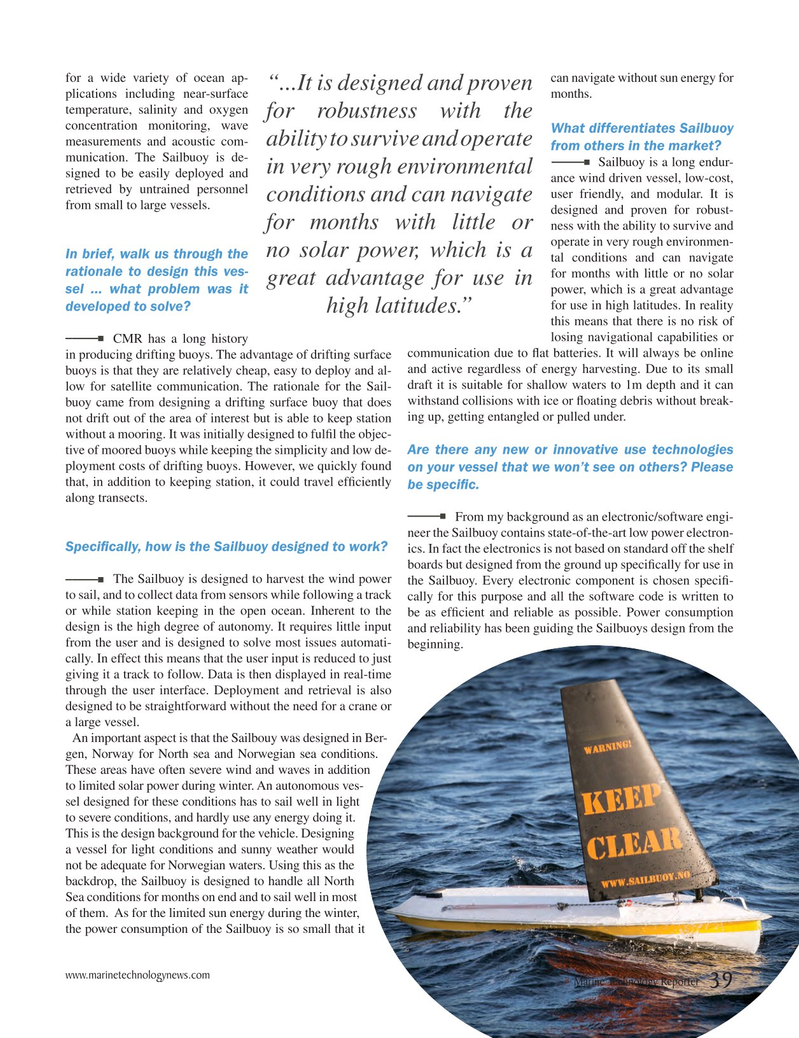
Page 39: of Marine Technology Magazine (June 2015)
Hydrographic Survey
Read this page in Pdf, Flash or Html5 edition of June 2015 Marine Technology Magazine
for a wide variety of ocean ap- can navigate without sun energy for “...It is designed and proven plications including near-surface months. temperature, salinity and oxygen for robustness with the concentration monitoring, wave
What differentiates Sailbuoy measurements and acoustic com- ability to survive and operate from others in the market?
munication. The Sailbuoy is de- Sailbuoy is a long endur- in very rough environmental signed to be easily deployed and ance wind driven vessel, low-cost, retrieved by untrained personnel user friendly, and modular. It is conditions and can navigate from small to large vessels.
designed and proven for robust- for months with little or ness with the ability to survive and operate in very rough environmen- no solar power, which is a
In brief, walk us through the tal conditions and can navigate rationale to design this ves- for months with little or no solar great advantage for use in power, which is a great advantage sel … what problem was it for use in high latitudes. In reality developed to solve?
high latitudes.” this means that there is no risk of losing navigational capabilities or CMR has a long history in producing drifting buoys. The advantage of drifting surface communication due to ? at batteries. It will always be online and active regardless of energy harvesting. Due to its small buoys is that they are relatively cheap, easy to deploy and al- draft it is suitable for shallow waters to 1m depth and it can low for satellite communication. The rationale for the Sail- buoy came from designing a drifting surface buoy that does withstand collisions with ice or ? oating debris without break- not drift out of the area of interest but is able to keep station ing up, getting entangled or pulled under.
without a mooring. It was initially designed to ful? l the objec- tive of moored buoys while keeping the simplicity and low de- Are there any new or innovative use technologies ployment costs of drifting buoys. However, we quickly found on your vessel that we won’t see on others? Please that, in addition to keeping station, it could travel ef? ciently be speci? c.
along transects. From my background as an electronic/software engi- neer the Sailbuoy contains state-of-the-art low power electron-
Speci? cally, how is the Sailbuoy designed to work?
ics. In fact the electronics is not based on standard off the shelf boards but designed from the ground up speci? cally for use in The Sailbuoy is designed to harvest the wind power the Sailbuoy. Every electronic component is chosen speci? - to sail, and to collect data from sensors while following a track cally for this purpose and all the software code is written to or while station keeping in the open ocean. Inherent to the be as ef? cient and reliable as possible. Power consumption design is the high degree of autonomy. It requires little input and reliability has been guiding the Sailbuoys design from the from the user and is designed to solve most issues automati- beginning. cally. In effect this means that the user input is reduced to just giving it a track to follow. Data is then displayed in real-time through the user interface. Deployment and retrieval is also designed to be straightforward without the need for a crane or a large vessel.
An important aspect is that the Sailbouy was designed in Ber- gen, Norway for North sea and Norwegian sea conditions.
These areas have often severe wind and waves in addition to limited solar power during winter. An autonomous ves- sel designed for these conditions has to sail well in light to severe conditions, and hardly use any energy doing it.
This is the design background for the vehicle. Designing a vessel for light conditions and sunny weather would not be adequate for Norwegian waters. Using this as the backdrop, the Sailbuoy is designed to handle all North
Sea conditions for months on end and to sail well in most of them. As for the limited sun energy during the winter, the power consumption of the Sailbuoy is so small that it www.marinetechnologynews.com
Marine Technology Reporter 39
MTR #5 (34-49).indd 39 MTR #5 (34-49).indd 39 6/11/2015 10:20:46 AM6/11/2015 10:20:46 AM

 38
38

 40
40
